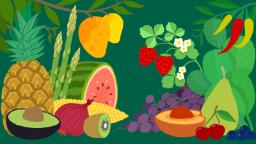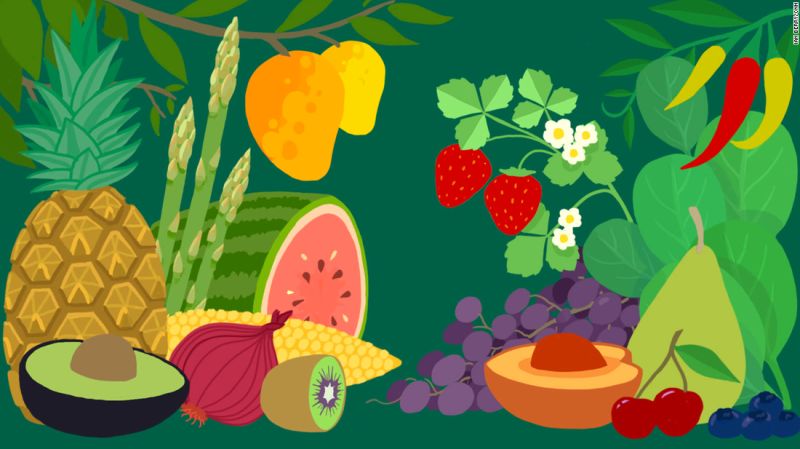
Editor’s Note: Sign up for CNN’s Eat, But Better: Mediterranean Style. Our eight-part guide shows you a delicious expert-backed eating lifestyle that will boost your health for life.
CNN
—
Blueberries, beloved by nutritionists for their anti-inflammatory properties, have joined fiber-rich green beans in this year’s Dirty Dozen of nonorganic produce with the most pesticides, according to the Environmental Working Group, a nonprofit environmental health organization.
In the 2023 Shopper’s Guide to Pesticides in Produce, researchers analyzed testing data on 46,569 samples of 46 fruits and vegetables conducted by the US Department of Agriculture. Each year, a rotating list of produce is tested by USDA staffers who wash, peel or scrub fruits and vegetables as consumers would before the food is examined for 251 different pesticides.
Dirty Dozen 2023
2023 Dirty Dozen (most to least contaminated)
As in 2022, strawberries and spinach continued to hold the top two spots on the Dirty Dozen, followed by three greens — kale, collard and mustard. Listed next were peaches, pears, nectarines, apples, grapes, bell and hot peppers, and cherries. Blueberries and green beans were 11th and 12th on the list.
A total of 210 pesticides were found on the 12 foods, the report said. Kale, collard and mustard greens contained the largest number of different pesticides — 103 types — followed by hot and bell peppers at 101.
“Some of the USDA’s tests show traces of pesticides long since banned by the Environmental Protection Agency. Much stricter federal regulation and oversight of these chemicals is needed,” the report said.
“Pesticides are toxic by design,” said Jane Houlihan, former senior vice president of research for EWG. She was not involved in the report.
“They are intended to harm living organisms, and this inherent toxicity has implications for children’s health, including potential risk for hormone dysfunction, cancer, and harm to the developing brain and nervous system,” said Houlihan, who is now research director for Healthy Babies, Bright Futures, an organization dedicated to reducing babies’ exposures to neurotoxic chemicals.
There is good news, though. Concerned consumers can consider choosing conventionally grown vegetables and fruits from the EWG’s Clean 15, a list of crops that tested lowest in pesticides, the report said. Nearly 65% of the foods on the list had no detectable levels of pesticide.
2023 Clean 15
2023 Clean 15 (least to most contaminated)
Avocados topped 2023’s list of least contaminated produce again this year, followed by sweet corn in second place. Pineapple, onions and papaya, frozen sweet peas, asparagus, honeydew melon, kiwi, cabbage, mushrooms, mangoes, sweet potatoes, watermelon, and carrots made up the rest of the list.
Being exposed to a variety of foods without pesticides is especially important during pregnancy and throughout childhood, experts say. Developing children need the combined nutrients but are also harder hit by contaminants such as pesticides.
“Pesticide exposure during pregnancy may lead to an increased risk of birth defects, low birth weight, and fetal death,” the American Academy of Pediatrics noted. “Exposure in childhood has been linked to attention and learning problems, as well as cancer.”
The AAP suggests parents and caregivers consult the shopper’s guide if they are concerned about their child’s exposure to pesticides.
Houlihan, director of Healthy Babies, Bright Futures, agreed: “Every choice to reduce pesticides in the diet is a good choice for a child.”
Nearly 90% of blueberry and green bean samples had concerning findings, the report said.
In 2016, the last time green beans were inspected, samples contained 51 different pesticides, according to the report. The latest round of testing found 84 different pest killers, and 6% of samples tested positive for acephate, an insecticide banned from use in the vegetable in 2011 by the EPA.
“One sample of non-organic green beans had acephate at a level 500 times greater than the limit set by the EPA,” said Alexis Temkin, a toxicologist at the EWG with expertise in toxic chemicals and pesticides.
When last tested in 2014, blueberries contained over 50 different pesticides. Testing in 2020 and 2021 found 54 different pesticides — about the same amount. Two insecticides, phosmet and malathion, were found on nearly 10% of blueberry samples, though the levels decreased over the past decade.
Acephate, phosmet and malathion are organophosphates, which interfere with the normal function of the nervous system, according to the US Centers for Disease Control and Prevention.
A high dose of these chemicals can cause difficulty breathing, nausea, a lower heart rate, vomiting, weakness, paralysis and seizures, the CDC said. If exposed over an extended time to smaller amounts, people may “feel tired or weak, irritable, depressed, or forgetful.”
Why would levels of some pesticides be higher today than in the past?
“We do see drops in some pesticides since the early ’90s when the Food Quality Protection Act was put into place,” Temkin said. “But we’re also seeing increases of other pesticides that have been substituted in their place which may not be any safer. That’s why there’s a push towards overall reduction in pesticide use.”
Chris Novak, president and CEO of CropLife America, an industry association, told CNN the report “willfully misrepresented” the USDA data.
“Farmers use pesticides to control insects and fungal diseases that threaten the healthfulness and safety of fruits and vegetables,” Novak said via email. “Misinformation about pesticides and various growing methods breeds hesitancy and confusion, resulting in many consumers opting to skip fresh produce altogether.”
The Institute of Food Technologists, an industry association, told CNN that emphasis should be placed on meeting the legal limits of pesticides established by significant scientific consensus.
“We all agree that the best-case scenario of pesticide residues would be as close to zero as possible and there should be continued science-based efforts to further reduce residual pesticides,” said Bryan Hitchcock, IFT’s chief science and technology officer.
Many fruits and veggies with higher levels of pesticides are critical to a balanced diet, so don’t give them up, experts say. Instead, avoid most pesticides by choosing to eat organic versions of the most contaminated crops. While organic foods are not more nutritious, the majority have little to no pesticide residue, Temkin said.
“If a person switches to an organic diet, the levels of pesticides in their urine rapidly decrease,” Temkin told CNN. “We see it time and time again.”
If organic isn’t available or too pricey, “I would definitely recommend peeling and washing thoroughly with water,” Temkin said. “Steer away from detergents or other advertised items. Rinsing with water will reduce pesticide levels.”
Additional tips on washing produce, provided by the US Food and Drug Administration, include:
- Handwashing with warm water and soap for 20 seconds before and after preparing fresh produce.
- Rinsing produce before peeling, so dirt and bacteria aren’t transferred from the knife onto the fruit or vegetable.
- Using a clean vegetable brush to scrub firm produce like apples and melons.
- Drying the produce with a clean cloth or paper towel to further reduce bacteria that may be present.

